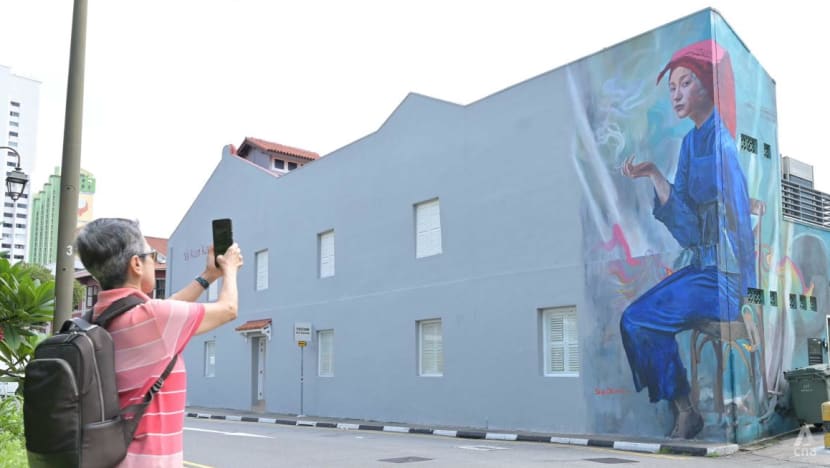Commentary: The controversy over the samsui woman mural is not just about art
The debate over the mural of a samsui woman holding a cigarette is a positive sign of Singapore’s maturation, says urban sketcher and art educator Ong Whee Teck.


This audio is generated by an AI tool.
SINGAPORE: In the world of urban visual art, every stroke of the brush tells a story, but sometimes, those stories ignite controversy. Recently, a Chinatown shophouse mural by Sean Dunston depicting a samsui woman with a cigarette has become the centre of a heated debate.
The issue came to light after Mr Dunston, an established artist, took to Instagram last week to highlight discussions happening behind the scenes, including a directive by the Urban Redevelopment Authority (URA) to remove the cigarette by Jul 3. Failing which, the restaurant housed in the building could potentially lose its temporary licence, he said.
The URA also cited a complaint by a member of the public who suggested the woman “looks more like a prostitute than a hardworking samsui woman” and called the mural “offensive” and “disrespectful”.
Mr Dunston’s response on Instagram was provocative. He defended the mural, asserting that sex workers deserve as much respect as the next person and questioned the narrow perceptions that drove the complaint.
It was later revealed that the mural was completed in early April without prior approval.
As a part-time art educator and sketcher, I believe the issue could have been handled more diplomatically. By focusing on a single complaint instead of addressing the failure of the artist and landlord to apply for the required permit, URA’s response appears to be more knee-jerk than measured. However, URA’s decision to re-evaluate its position over changes to the mural is a step in the right direction.
LISTEN: Samsui woman debate - who’s got the mural authority?
NO RIGHTS NO WRONGS IN ART?
Many artists argue that art should remain untouched, yet this ideal is complex in practice.
The discourse surrounding this mural reveals deep-seated perceptions of samsui women in the Singaporean psyche. Traditionally, these women are viewed as stoic labourers, a stereotype that Mr Dunston’s depiction challenges.
While some see the mural as a necessary break from tradition, others view it as a misrepresentation. The controversy underscores the broader tension between preserving historical narratives and embracing modern artistic interpretations.
Weighing in on the issue, renowned Singaporean muralist Yip Yew Chong said in an Instagram post that samsui women, like everyone else, had diverse personalities and that smoking was not uncommon among them. He stressed that art is meant to evoke emotion and provoke thought, not merely document history with photographic accuracy.
At the same time, however, he also underscored the need for sensitivity in public art, acknowledging that while art shouldn't be overly sanitised, it must consider the community's feelings and cultural context.
In his post, Mr Yip underscored the challenges of balancing creative expression with societal norms, and reflected on his own experiences of censorship and adapting his art to meet public standards without losing its essence.
He emphasised the importance of dialogue and collaboration with authorities, advocating for a more relaxed yet principled approach to art censorship in Singapore.
PUBLIC DISCOURSE ON ART A SIGN OF SINGAPORE’S MATURATION
The controversy surrounding the samsui woman mural is not just about a single piece of art; it is about how Singapore sees itself and its future. It is about the kind of society it wants to be - one that is open to new ideas and expressions, or one that clings to outdated notions and stereotypes. The boundary between respecting traditions and embracing modernity is delicate, but it is one that Singapore must navigate carefully.
On Tuesday (Jun 25), women’s rights group AWARE Singapore was forced to backtrack after public outcry over its initial response that the mural may “perpetuate a male gaze that exoticises female subjects”.
Singapore is at a crossroads, transitioning from its formative years into a more mature phase. Historically, the country has carefully managed various aspects of life, including art, to foster growth and stability. This approach was essential during its early development. However, as Singapore evolves, there is an increasing opportunity to embrace greater flexibility and openness in creative expression.
The debate over Mr Dunston’s mural is emblematic of this transition. As society becomes more educated and cosmopolitan, it must allow for greater freedom and expression. Artists should be allowed to be edgy and provocative, as it is one powerful way to create impact.
Public discourse on art is a positive sign of Singapore’s maturation. It reflects a society that is increasingly willing to engage with diverse perspectives and challenge the status quo.
Creativity is not just a matter of cultural enrichment but a vital element for the survival and flourishing of society. By fostering an environment where artistic expression can thrive, Singapore will continue to evolve and find deeper meaning in its vibrant, highly educated community.
Ong Whee Teck is an urban sketcher, author, founder and part-time art educator at Singapore Sketchers.
















